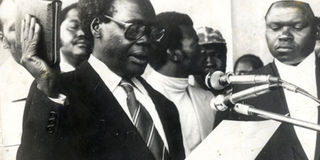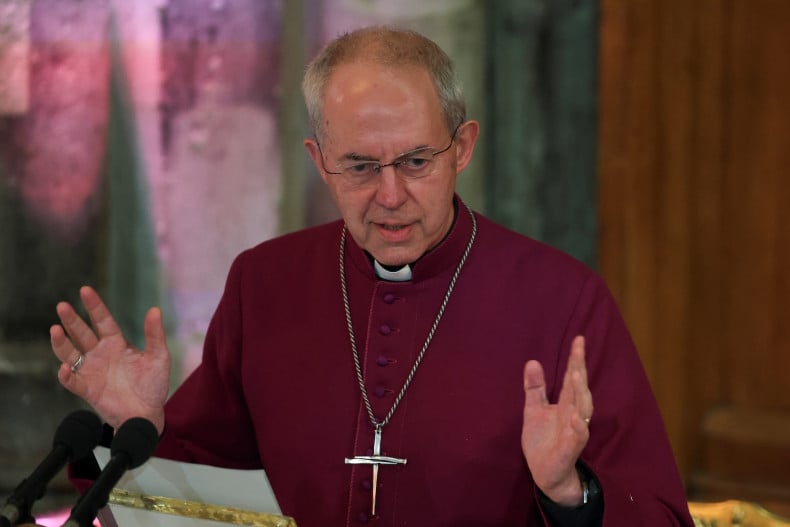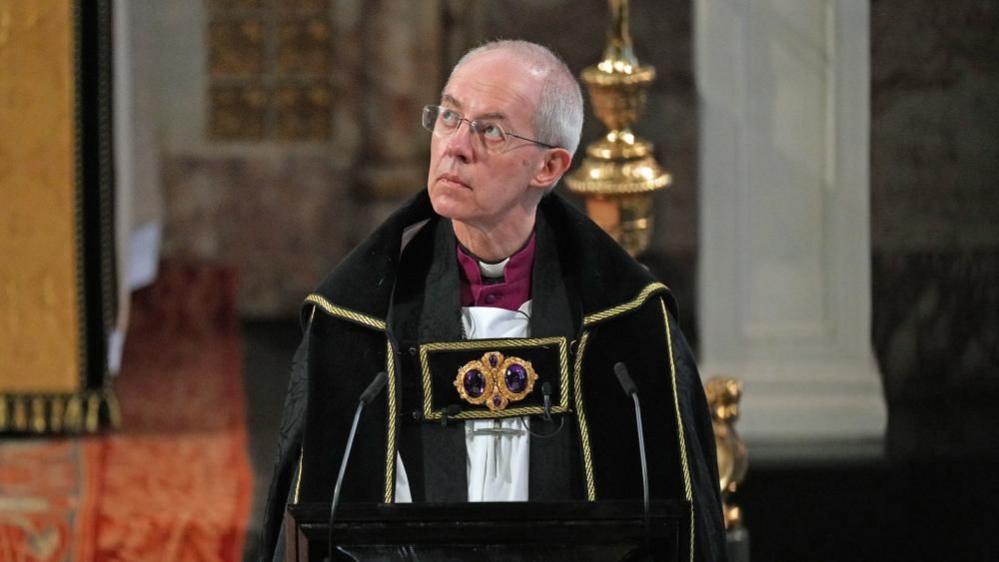Prime
Intrigue, mistrust as Uganda prepares for 1980 election

Uganda Peoples Congress’ Milton Obote is sworn in as president after the disputed 1980 general election. FILE PHOTO
There is no general election in Ugandan history that has been as discussed and disputed as the election that took place on December 10, 1980.
It was the election that provided the pretext for certain political and military groups to take up arms against the government.
Subsequent attempts since the mid-1990s by some groups to moot the idea of starting a guerrilla war against the NRM government have drawn their inspiration from what happened soon after that fateful 1980 election.
In this analysis, we examine that controversial election and the issues and players that led up to it.
The 1980 election came just over two years after the start of the Uganda-Tanzania war.
The post-war UNLF period
Soon after the ouster from power of Idi Amin in April 1979, the political elite of the new Uganda National Liberation Front (UNLF) government headed by Yusuf Lule began to look ahead.
The immediate task at hand was reconstruction and rehabilitation of the country’s infrastructure and economy.
Much of the colonial infrastructure that had been in place since independence came under major devastation for the first time. Arua, Masaka, Mbarara and parts of Kampala saw substantial physical damage.
Where there was no physical damage, the extensive looting that followed the fall of the Idi Amin regime destroyed much of the collective record-keeping and documentation of the country.
There was a nationwide scarcity of most basic consumer goods such as salt, sugar, toilet paper, toothpaste and cooking oil.
In 1979, the European Economic Community, forerunner to the present European Union, started to send relief aid to Uganda. This was the beginning of the kind of dependence on foreign donors that 36 years later has become a permanent feature of Ugandan life.
The other preoccupation of the UNLF government and its various rival factions was Uganda’s political future. The UNLF was regarded as only an interim administration. The government that would replace this interim regime would have to come to power in a general election.
The former government of the Uganda Peoples Congress (UPC) party that was ousted in January 1971 by Amin and the former ruling and former opposition party, the Democratic Party (DP), were the natural favourites to win any general election that took place, whenever it took place.
Uganda since the early 1960s had been a two-party state with public support divided almost roughly equally between the DP and UPC.
Much of the news and public and private political discussion in 1979 and 1980 revolved around the suspicion that there were powerful military and political actors who planned to eventually return former president Milton Obote to power.
The first event to confirm or heighten this suspicion was the shock ouster after only two months in office of president Lule in June 1979 in a vote at State House Entebbe by members of the National Consultative Council (NCC), which acted at the time as Uganda’s interim Parliament.
The ouster of Lule was the climax of the ideological struggle between Socialist-leaning, mostly UPC members of the NCC and Capitalist-leaning, largely Baganda and mostly DP members of the NCC.
To raise suspicions even further, the man selected to succeed Lule was Godfrey Binaisa, a former Attorney General in the 1960s who had helped draft the emergency 1966 Constitution and was known to be pro-UPC.
The government military attack on Kabaka Edward Mutesa’s palace in May 1966, the exiling of the Kabaka in Britain, the abolition of the four traditional kingdoms of Ankole, Buganda, Bunyoro and Tooro the death in exile in November 1969 of Mutesa, were deeply traumatic events for the Baganda, Uganda’s largest and most influential tribe.
Paranoia over the prospect of a return to power gripped the country, especially Buganda.
Museveni’s military preparations
After he was named minister of State for Defence shortly after the fall of the Amin government and later as minister of Defence, Yoweri Museveni started a secret recruitment of young men into the new national army, the Uganda National Liberation Army (UNLA).
Most of these recruits were done in Ankole and from among the Rwandan Tutsi refugees. There were also a few recruitments made in Buganda.
These recruits, more than 4,000 young men and women in number, were incorporated into the UNLA.
Of these, 126 of the better-educated men were sent to Munduli, Tanzania, for officer cadet training at the army college.
Museveni, in other words, used his official government position and structures and resources of State to recruit a personal army and political group.
This partly explains why 34 years later, Museveni now as head of State got seriously alarmed at rumours and reports that the prime minister Amama Mbabazi was doing exactly what he, Museveni, had done in 1979.
Then minister of Internal Affairs, Paulo Muwanga, warned president Godfrey Binaisa in 1979 that most of the cadet officers undergoing training at Munduli, as well as many stationed at the army barracks in Kabamba and Moroto were Museveni’s Fronasa men.
It was not just Muwanga who was alarmed at Museveni’s moves. Many leading politicians, especially those from UPC, strongly suspected that Museveni was making preparations for a future war against the Uganda government.
Binaisa heeded Muwanga’s urgent warning that Museveni’s secret recruitment into the UNLA was a threat both to Binaisa and to Uganda.
In a Cabinet reshuffle in November 1979, president Binaisa transferred Museveni from the Ministry of Defence to the Ministry of Regional Cooperation. Museveni replaced Ateker Ejalu in that new capacity.
In February 1980, president Binaisa removed Muwanga as minister of Internal Affairs and named him minister of Labour.
Muwanga as minister of Internal Affairs had banned three newspapers that had been publishing reports on the rampant political murders in the country.
However, Muwanga remained the chairman of the UNLF’s Military Commission. The Military Commission was a kind of High Command of the UNLF and was widely regarded as the real power in Uganda. Museveni was the vice chairman of the Military Commission.
On May 10, 1980, president Binaisa announced another reshuffle. The army chief of staff, Brig David Oyite-Ojok, was relieved of his duties and appointed as Uganda’s new ambassador to Algeria.
According to Muwanga and Oyite-Ojok, Binaisa had, like Lule, acted unconstitutionally.
The following day, May 11, the Military Commission announced that Binaisa had been relieved of his duties as president in the second major political shock in less than a year.
The Military Commission then took effective control of the country. With Lule and Binaisa sacked, with the Military Commission led by the UPC member Muwanga, Oyite-Ojok and perceived as dominated by the UPC, it now became clear to many that everything since Amin’s ouster in April 1979 had been orchestrated to return Obote to power.
In yet another event that seemed to lend weight to this now widespread suspicion, Obote returned to Uganda on May 27, 1980, after nine years in exile in Tanzania and only 16 days after Binaisa’s ouster.
What more evidence was needed to those suspicious of the Military Commission, that this was all a slowly unfolding process of returning Obote to power?
From here, events started to move fast. It was announced by the government that a general election would be held on September 30, 1980. On June 4, 1980, the Military Commission’s vice chairman, Museveni, launched a new party, the Uganda Patriotic Movement (UPM).
Obote announced that he would seek the presidency in the general elections later that year. A fourth presidential candidate was the former Katikkiro of Buganda and president of the new Conservative Party (CP), Joash Mayanja-Nkangi.
The DP prepares for war
In August 1980, several DP leaders flew to London to try and raise funds and support for a secret plan to launch a guerrilla war after the 1980 elections.
Among the DP delegation were Boniface Byanyima, Sam Kutesa and a young DP activist Specioza Naigaga.
The former deputy minister of Internal Affairs under the Lule government Andrew Kayiira, also started to secretly recruit men and assemble arms for a new guerrilla force called the Uganda Freedom Movement (UFM).
With the campaigns now underway, UPC and UPM supporters had frequent encounters and several of them were violent. Finally at a rally in Hoima on July 11, 1980, UPC president, Milton Obote, gave UPM a “final warning” over the harassment of UPC supporters by UPM youth wingers.
That same day, July 11, 1980, UPM presidential candidate Museveni said in a statement that he was not aware of any plans by the Military Commission to rig the forthcoming elections and install Obote as Uganda’s head of state.
This particular statement is significant because it sheds light on Museveni’s thinking and the political situation at the time. During the campaigns, Museveni tended to speak openly and frankly.
Had he suspected that the Military Commission planned to hand the election to Obote, he would have said so in this statement.
In fact, on August 13, 1980, at a campaign rally in Mukono, Museveni criticised the DP president and presidential candidate Paulo Ssemogerere for “telling the people of Uganda that the DP has already won elections”.
On July 15, 1980, the government named a five-man national Electoral Commission. The chairman of the Electoral Commission was named as K.M.S Kikira. Commissioners included Sam Egweu, A. Kera A. Ahmed Bilali and M. Matovu. Vincent Sekkono was the secretary to the commission.
On September 18, 1980, it was announced that the general election would not now take place on September 30 as had been previously scheduled and would now take place on December 10, 1980.
At a news conference in Kampala on November 26, 1980, Ssemogerere said he and the DP were satisfied with the preparations made so far by the Military Commission to hold free and fair elections.
So within the space of four months, two presidential candidates Ssemogerere and Museveni publicly issued statements expressing satisfaction with the Military Commission over preparations for a free and fair election (Ssemogerere) and refuting reports that the Military Commission planned to rig the election in favour of Obote (Museveni).
On November 24, 1980, a 70-member Commonwealth election observer team headed by Ghana’s Ebenezer Deborah arrived in Uganda to monitor the forthcoming elections.
This was the first time in the history of the Commonwealth that election observers were dispatched to a member state to oversee general elections.
Finally on December 10, 1980, millions of Ugandans started voting in their first general election since 1962. The turnout was heavy. Reports of rigging by some UPC and DP party activists and candidates began to filter through.
Before the results were announced, the DP started to declare that it had won the elections, something that the UPM candidate Yoweri Museveni had criticised the DP over three months earlier.
When the DP started announcing that it had won the election and thousands of its supporters were celebrating in the streets of Kampala, the chairman of the Military Commission, Paulo Muwanga, issued an announcement over the state-owned Radio Uganda ordering anybody prematurely claiming victory to cease doing so and await the Electoral Commission’s announcement.
Worst fears about to come to pass
This announcement by Muwanga, given the events since the ouster of Lule and Binaisa and the suspicion of a plan to restore Obote to power, once again got many experts believing that their worst fears were about to come to pass.
The following day, December 11, 1980, as initial results start coming in, a pattern suggesting a landslide victory by the UPC started becoming clear.
The Commonwealth observer team said the process so far was “a valid electoral exercise which should broadly reflect the freely expressed choice of the people of Uganda.”
On December 18, 1980, Ssemogerere addressed a press conference in Kampala at which he said the officially announced results declaring Obote and the UPC the winners had been a reversal of the actual results.
But, added Ssemogerere, the DP would respect the results in order to avoid plunging Uganda into bloodshed.
In a statement on December 18, 1980, the UPM executive committee issued a statement saying: “The UPC has already (started) off as in the late 1960s deriving it’s power fraudulency backed by the gun.”
In London, the Commonwealth observer group issued their final report on the elections and explained how the DP had inaccurately claimed victory and the final victory rightfully belonged to the UPC.
And with that, the observers said the December 10, 1980, elections had generally been free and fair.
1980 official election results
Uganda Peoples Congress: 72 seats
Democratic party: 51 seats
Uganda Patriotic Movement: 1 seat
Conservative Party: None
Not declared: 2 seats
Total: 126 seats




